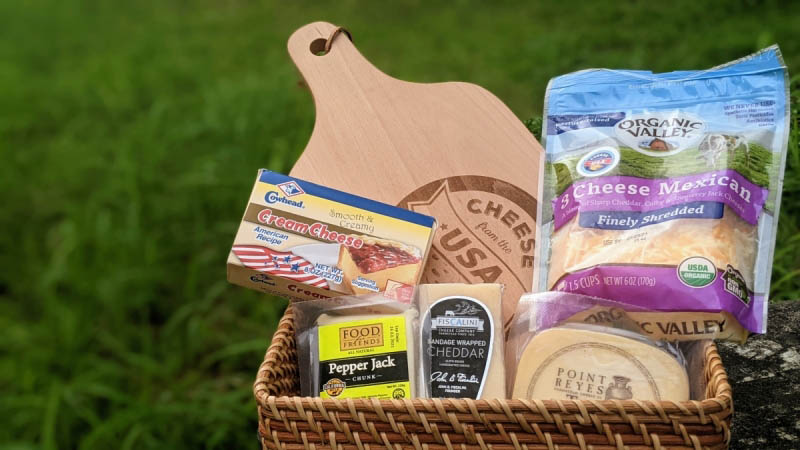FYI-DAY FACTS: USA Cheese

It’s easy to say that cheese is one of the most popular food items within the household at this point. Whether you’re eating a simple sandwich, having something to clear your palate after a heavy meal, or simply looking for something light to snack on, cheese is a very common ingredient for a household. And it’s clear how much the USA love their cheese. Boasting over 1,000 cheese varieties, the United States is not only the world's largest cheese producer, but also one of the most diverse. Hundreds of years of excellence stemming from a melting pot of backgrounds and cultures makes the United States a unique and exciting supplier of delicious cheese.
The month of June is National Dairy Month, and the last week of June is dedicated to the National Cheese Week.
Some of the biggest cheese producers in the USA hail from the Midwest state of Wisconsin, but dairy farming can happen from the hot, dry, open spaces of the West to the seasonally temperate, nutrient-rich fields of the Northeast to the hot, humid holdings of the Southeast. This helps supports year-round milk production in the United States, and makes the U.S. the world's largest single-country cow's milk producer, with 99.1 million metric tons of milk in 2019. U.S. milk production encompasses 9.3 million cows on 40,000 U.S. dairy farms across all 50 states, with over half of 2019 volume from the top five U.S. milk-producing states of California, Wisconsin, New York, Idaho and Texas.
But how does that work? It starts with making sure the cows are healthy and well-tended, fed a nutritious diet consistently to produce wholesome, high-quality milk.
U.S. dairy farmers work closely with animal nutritionists and veterinarians to identify the right mix of feed ingredients to meet cows' nutritional requirements.
The components of a dairy cow's diet typically combine hay (like alfalfa or grass), grains (including corn, wheat and barley) and protein sources (like soybeans and canola) with vitamin and mineral supplements. A steady and healthy planned diet combines with the dairy cow's powerful digestive system's ability to maximize the dietary nutrients to produce wholesome, high-quality milk throughout the year. The steady supply is bolstered by minimal season-to-season variance in feed quantity and nutrient composition, in contrast to the cyclical volume typical of dairy cows that graze, which is common in some parts of the world.
The majority of U.S. dairy farms are family-owned and operated, so there’s a wealth of knowledge to draw from to make the herds thrive best. In terms of living environment, American-style barns are designed to protect cows from the weather, including wind and moisture. Installation of ceiling fans and water jets in the barns keep cows cool in the summer heat. The amount of rest a cow gets also directly influences how much milk she produces. U.S. dairy farmers often use sand bedding, as well as, more recently, water beds, to optimize a refreshing rest time.
U.S. dairy farmers work year-round to ensure cow comfort, and well-tended dairy cows respond by producing more milk. In fact, today's annual average of 10,600 kilograms per U.S. cow average more than doubles the 1970 U.S. average of 4,400 kilograms per cow. (Source: USDA)
It’s fascinating just seeing how much the U.S.A contributes to the global cheese production. And a lot of the way we discuss the USA Cheese production and knowledge comes from the
U.S. Dairy Export Council (USDEC). Their work is to educate and showcase American dairy farmers and the entire U.S. cheese community to the world, building a global awareness of the excellent Cheeses from the USA. Through education and promotions, the Guild aims to inform customers about the craftsmanship, innovation, variety, and versatility of USA cheeses.
Instagram: @USAcheese Guildsg
Facebook: @USAcheeseGuildsg Linkedin: @USAcheese Guild
 It’s easy to say that cheese is one of the most popular food items within the household at this point. Whether you’re eating a simple sandwich, having something to clear your palate after a heavy meal, or simply looking for something light to snack on, cheese is a very common ingredient for a household. And it’s clear how much the USA love their cheese. Boasting over 1,000 cheese varieties, the United States is not only the world's largest cheese producer, but also one of the most diverse. Hundreds of years of excellence stemming from a melting pot of backgrounds and cultures makes the United States a unique and exciting supplier of delicious cheese.
It’s easy to say that cheese is one of the most popular food items within the household at this point. Whether you’re eating a simple sandwich, having something to clear your palate after a heavy meal, or simply looking for something light to snack on, cheese is a very common ingredient for a household. And it’s clear how much the USA love their cheese. Boasting over 1,000 cheese varieties, the United States is not only the world's largest cheese producer, but also one of the most diverse. Hundreds of years of excellence stemming from a melting pot of backgrounds and cultures makes the United States a unique and exciting supplier of delicious cheese.